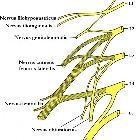Plexus lumbosacralis

Vagusgruppe,
Image:Gray822.png, nachbearbeitet und Beschriftung modifiziert (Deutsch/german) von de:Benutzer:Uwe Gille

Femoral nerve
• Lumbar plexus diagrams - Ganzer Fall bei Radiopaedia
The lumbar plexus is a complex neural network formed by the lower thoracic and lumbar ventral nerve roots (T12 to L5) which supplies motor and sensory innervation to the lower limb and pelvic girdle.
Summary
- origin: ventral rami of T12 to L5
- course: formed within the substance of the psoas major muscle, anterior to the lumbar transverse processes
- major (terminal) branches
- motor supply: lower limb and pelvic girdle
- sensory supply: lower anterior abdominal wall, groin, upper thigh and pudenda
Gross anatomy
The branches that arise from the lumbar plexus are:
- subcostal nerve: T12
- Iliohypogastric nerve: L1
- ilioinguinal nerve: L1
- genitofemoral nerve: L1, 2
- lateral femoral cutaneous nerve: L2, 3
- femoral nerve: L2, 3, 4
- obturator nerve: L2, 3, 4
- lumbosacral trunk: L4, 5
- this contributes to the sacral plexus
The branches of the lumber plexus are covered in this mnemonic.
Variant anatomy
Variation in the lumbar plexus appears to be common (~90% in one study) :
- absent iliohypogastric nerve (~20%)
- early branching (within psoas muscle) of the genitofemoral nerve (~20%)
- accessory obturator nerve (~10%)
- lateral femoral cutaneous nerve arising as a branch of the femoral nerve
Siehe auch:
und weiter:

